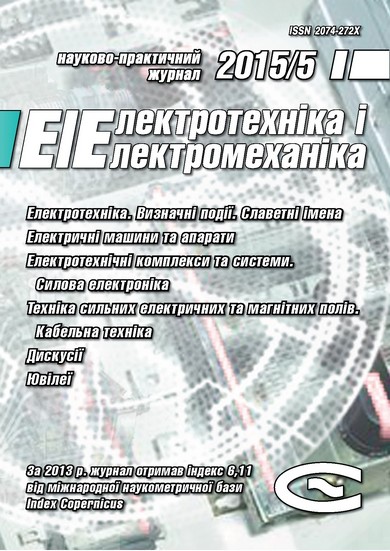THE ABSORPTION CHARACTERISTICS OF THE PHASE AND ZONE PAPER-IMPREGNATED INSULATION OF POWER CABLE AT DIRECT VOLTAGE
DOI:
https://doi.org/10.20998/2074-272X.2015.5.09Keywords:
phase and zone paper-impregnated insulation, absorption characteristics, polarization index, insulation resistance, equivalent circuit, the system of linear algebraic equations, stability of the solutionAbstract
Introduction. The moral and physical deterioration of medium voltage power cables with phase and zone paper-impregnated insulation requires implementation of quality systems and reliable nondestructive electric diagnostic. Informative indicator of the insulation is the time decay curve of the charging current. It reflects the processes of accumulation of space charges (absorption). The measurements are carried out the 15th since the second direct voltage supply, then – on the 30th and the second on the 60th second. The ratio of the parameters measured in these times gives the dimensionless criteria – absorption coefficients. Three measurements are made at different times, provide a more complete picture of the state of insulation than the measurement of the value of steady leakage (conduction-through), adopted in conventional prevention trials. Purpose. Research and testing methods of diagnostics of power cables with paper-impregnated insulation by absorption and phase characteristics of the belt insulation based on the total measurements. Methodology. A procedure for determining the individual characteristics of phase and zone paper-impregnated insulation based realized on the use of the equivalent circuit of a three-core cable in the metal shell and solved of an over determined system of linear algebraic equations by least squares. Results. The proposed method allows determining the absorption characteristics of the individual phase and zone insulation medium voltage power cables in the overall metal shell at a direct voltage. Individual characteristics reflect the characteristics of cables and allow a greater degree to assess the degree of aging of each of the components of paper-impregnated insulation. Originality. Regardless of the cable connection diagrams probing electric field grabs as the phase, and zone insulation. The cumulative nature of the measurement leads to the fact that the differences in the properties of insulation components are smoothed: the aggregate results of the measurements do not differ for the different schemes of the same type. The individual characteristics of isolation, defined on the basis of the proposed method are more differences than total, indicating that non-symmetrical modes of operation of the cable. Practical value. The values of individual characteristics power cables 6 kV are 3 times more total, because of what their direct measurement may be a problem. The total resistance of several insulation spaces connected in parallel, behind the individual. Smaller values of insulation resistance are measured more easily, especially on short samples cables.
References
Kaniskin V.A., Kocur S.A., Privalov I.N. Cables of 10 kV with paper-impregnated insulation. Non-destructive electrical diagnostics. Novosti elektrotehniki – Electrical engineering news, 2005, no.5(35), pp.25-34. (Rus).
Privalov I.N. Nondestructive diagnosis of power cable lines rated voltage 6-35 kV. Elektrotekhnicheskii rynok – Electrotechnical market, 2008, no.2, pp. 17-25. (Rus).
Naboka B.G., Bezprozvannych A.V., Moskvitin E.S. Tekhnicheskoe sostoianie kabelei energoblokov AES: silovye kabeli s bumazhno-maslianoi izoliatsiei [Technical condition of the cables NPP: power cables with paper-oil insulation]. Problemy obespecheniia bezopasnosti informatsionnykh i upravliaiushchikh sistem AES: sbornik nauchnykh trudov [Problems of safety and control systems NPP: Collection of scientific papers], 2010, pp. 262-271. (Rus).
Bezprozvannych A.V., Moskvitin E.S. Estimation criteria for degree of paper-impregnated insulated power cable ageing. Elektrotekhnika i elektromekhanika – Electrical engineering & electromechanics, 2013, no.4, pp. 32-36. (Rus).
Bezprozvannych A.V., Moskvitin E.S. Modern methods of power control and diagnostics of power cables with cross-linked polyethylene insulation. Elektricheskie seti i sistemy – Electrical networks and systems, 2013, no.5, pp. 35-40. (Rus).
Bezprozvannych A.V., Naboka B.G., Moskvitin E.S. Examination of the three-phase insulation of cables in a metal shell. Elektrichestvo – Electricity, 2010, no.1, pp. 48-54. (Rus).
Bezprozvannych A.V, Naboka B.G. Matematicheskie modeli i metody rascheta elektroizoljacionnyh konstrukcij [Mathematical models and methods of calculation electrical insulation constructions]. Kharkov, NTU «KhPI» Publ., 2011. 92 p. (Rus).
Bezprozvannych A.V. Analysis of a switching matrix under recovery of partial capacitance and dielectric loss tangent of multicore cables via cumulative measurements. Elektrotekhnika i elektromekhanika – Electrical engineering & electromechanics, 2007, no.1, pp. 62-66. (Rus).
Downloads
Published
How to Cite
Issue
Section
License
Copyright (c) 2015 G. V. Bezprozvannych, E. S. Moskvitin, A. G. Kyessayev

This work is licensed under a Creative Commons Attribution-NonCommercial 4.0 International License.
Authors who publish with this journal agree to the following terms:
1. Authors retain copyright and grant the journal right of first publication with the work simultaneously licensed under a Creative Commons Attribution License that allows others to share the work with an acknowledgement of the work's authorship and initial publication in this journal.
2. Authors are able to enter into separate, additional contractual arrangements for the non-exclusive distribution of the journal's published version of the work (e.g., post it to an institutional repository or publish it in a book), with an acknowledgement of its initial publication in this journal.
3. Authors are permitted and encouraged to post their work online (e.g., in institutional repositories or on their website) prior to and during the submission process, as it can lead to productive exchanges, as well as earlier and greater citation of published work.





